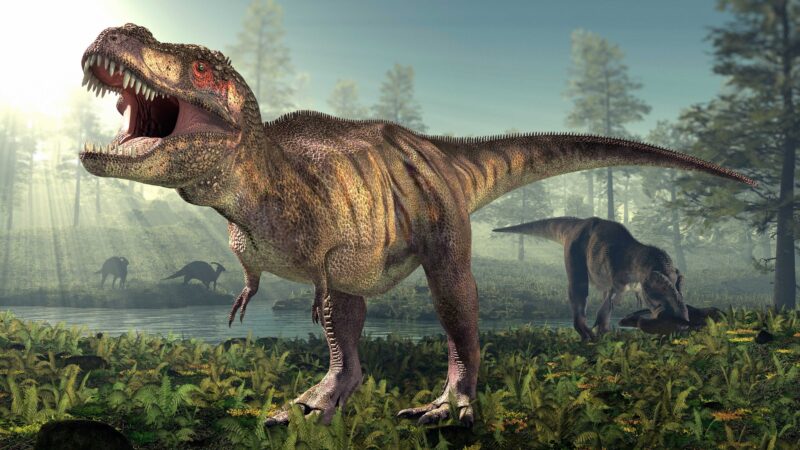Tyrannosaurus rex towered over many other dinosaurs. But the biggest of the king of the dinos may have been even heftier than fossils hint.
Only around 80 fossil T. rex skeletons have been found so far, and not all of them are complete. “We know that there must have been millions and billions of T. rex on Earth,” says Jordan Mallon. This paleontologist works at the Canadian Museum of Nature in Ottawa. It’s unlikely that the biggest T. rex ever is among those 80 skeletons. A group of 80 people picked at random probably wouldn’t include the tallest person on Earth.
Explainer: How a fossil forms
To calculate the potential size of the biggest T. rex, Mallon teamed up with David Hone. He’s a paleontologist at Queen Mary University in London, England.
Scientists have estimated that some 2.5 billion T. rex may have once roamed Earth. But not all would have made it to adulthood. “Most of them didn’t,” Mallon says. “They were picked off by other predators. Or they died of disease. Or they got trampled by a Triceratops.” To calculate the spread of sizes across a large group, Mallon’s team used a computer model. The computer couldn’t handle 2.5 billion dinos, so the pair went with 140 million.
Explainer: What is statistics?
The researchers based the spread of ages for the 140 million T. rex on alligators — living relatives of T. rex. They used mathematical tools called statistics. Statistics can use known information from a small group — such as the 80 fossils — to calculate trends for a much larger group.
Based on an animal’s bones, scientists can figure out its rough age and weight. Using this information from reports on fossils, Mallon and Hone worked out how T. rex body mass increased with age. But just like other animals, not all dinos of the same age are the same size. The researchers reasoned that the variation in sizes among T. rex individuals may have resembled that of alligators. Alligators are one of the largest reptiles alive today, and they’re meat eaters like T. rex was. This allowed the scientists to estimate body sizes for the 140 million dinos in their group. They used statistics again to find the biggest potential size in a batch of 2.5 billion T. rex.
“We estimate that the largest conceivable T. rex was probably 70 percent larger than the biggest animal we know of currently,” Mallon says. “That’s a bit of a mind-boggling thing to think about.” This dino would be 15 meters (49 feet) long and weigh 15,000 kilograms (33,000 pounds). Mallon and Hone shared their results in July in Ecology and Evolution.
This size is just a rough estimate. “It’s a bit of a thought experiment,” Mallon says. Mallon and Hone don’t have the fossils to back up their hypothesis. And it’s not clear yet whether the bones of this enormous animal could support the weight suggested by the new study.
It could be a long wait till such a behemoth is found. Based on the rate at which fossils are unearthed, it could be decades until a T. rex bigger than 99.9 percent of all others is found. And it could take millennia to dig up one that’s in the species’ top 0.01 percent.
Data Dive:
Look at Figure A. What is the body mass of a T. rex that is about 12 years old? What about a T. rex that is 20 years old?
How does T. rex’s growth during the teenage years (13 to 19) compare with its growth after age 20?
Think about how humans grow. How does T. rex’s growth compare with that of humans?
Look at Figure B. What does the spread of body mass values look like for T. rex at age 10 and below? What does it look like for T. rex after age 10?
What is the range of body mass values for T. rex individuals that are 15 years old? What about 25 years old?
What is the likely age of the biggest T. rex that ever lived?




